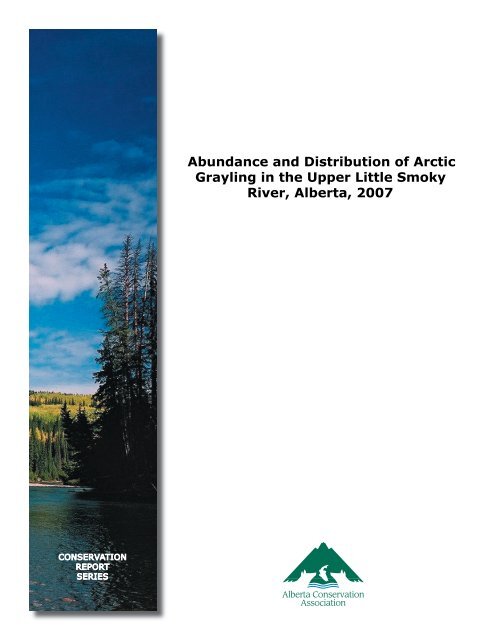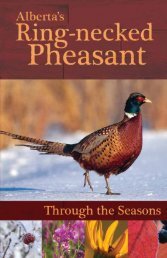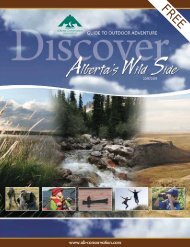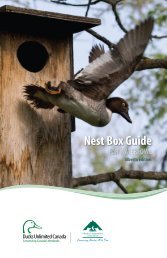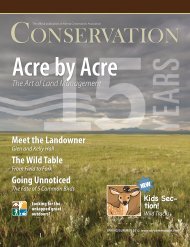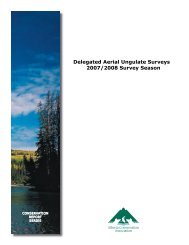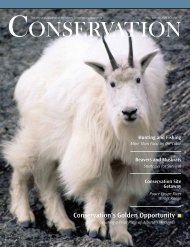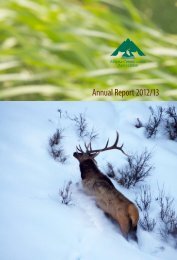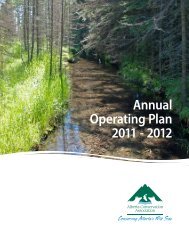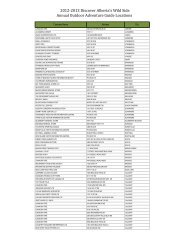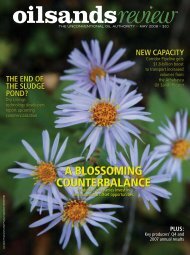Abundance and Distribution of Arctic Grayling in the Upper Little ...
Abundance and Distribution of Arctic Grayling in the Upper Little ...
Abundance and Distribution of Arctic Grayling in the Upper Little ...
You also want an ePaper? Increase the reach of your titles
YUMPU automatically turns print PDFs into web optimized ePapers that Google loves.
<strong>Abundance</strong> <strong>and</strong> <strong>Distribution</strong> <strong>of</strong> <strong>Arctic</strong><br />
<strong>Grayl<strong>in</strong>g</strong> <strong>in</strong> <strong>the</strong> <strong>Upper</strong> <strong>Little</strong> Smoky<br />
River, Alberta, 2007<br />
CONSERVATION<br />
REPORT<br />
SERIES
The Alberta Conservation Association is a Delegated Adm<strong>in</strong>istrative<br />
Organization under Alberta’s Wildlife Act.<br />
CONSERVATION<br />
REPORT<br />
SERIES<br />
25% Post Consumer Fibre<br />
When separated, both <strong>the</strong> b<strong>in</strong>d<strong>in</strong>g <strong>and</strong> paper <strong>in</strong> this document are recyclable
<strong>Abundance</strong> <strong>and</strong> <strong>Distribution</strong> <strong>of</strong> <strong>Arctic</strong> <strong>Grayl<strong>in</strong>g</strong><br />
<strong>in</strong> <strong>the</strong> <strong>Upper</strong> <strong>Little</strong> Smoky River, Alberta, 2007<br />
Kev<strong>in</strong> Fitzsimmons<br />
Alberta Conservation Association<br />
Box 1420, Cochrane, Alberta, Canada<br />
T4C 1B4<br />
Mike Blackburn †<br />
Alberta Conservation Association<br />
#203, Prov<strong>in</strong>cial Build<strong>in</strong>g, 111 – 54 Street<br />
Edson, Alberta, Canada<br />
T7E 1T2<br />
†<br />
Current Address: Alberta Susta<strong>in</strong>able Resource Development<br />
111 ‐ 54 Street, Edson, Alberta, Canada, T7E 1T2
Report Editors<br />
PETER AKU<br />
KELLEY KISSNER<br />
Alberta Conservation Association<br />
50 Tuscany Meadows Cres NW<br />
#101, 9 Chippewa Rd Calgary, AB T3L 2T9<br />
Sherwood Park, AB T8A 6J7<br />
Conservation Report Series Type<br />
Data<br />
ISBN pr<strong>in</strong>ted: 978‐0‐7785‐8460‐5<br />
ISBN onl<strong>in</strong>e: 978‐0‐7785‐8461‐2<br />
Publication No.: I/347<br />
Disclaimer:<br />
This document is an <strong>in</strong>dependent report prepared by <strong>the</strong> Alberta Conservation<br />
Association. The authors are solely responsible for <strong>the</strong> <strong>in</strong>terpretations <strong>of</strong> data <strong>and</strong><br />
statements made with<strong>in</strong> this report.<br />
Reproduction <strong>and</strong> Availability:<br />
This report <strong>and</strong> its contents may be reproduced <strong>in</strong> whole, or <strong>in</strong> part, provided that this<br />
title page is <strong>in</strong>cluded with such reproduction <strong>and</strong>/or appropriate acknowledgements<br />
are provided to <strong>the</strong> authors <strong>and</strong> sponsors <strong>of</strong> this project.<br />
Suggested Citation:<br />
Fitzsimmons, K., <strong>and</strong> M. Blackburn. 2009. <strong>Abundance</strong> <strong>and</strong> distribution <strong>of</strong> <strong>Arctic</strong><br />
grayl<strong>in</strong>g <strong>in</strong> <strong>the</strong> upper <strong>Little</strong> Smoky River, Alberta, 2007. Data Report, D‐2009‐<br />
004, produced by <strong>the</strong> Alberta Conservation Association, Cochrane, Alberta,<br />
Canada. 16 pp + App.<br />
Cover photo credit:<br />
David Fairless<br />
Digital copies <strong>of</strong> conservation reports can be obta<strong>in</strong>ed from:<br />
Alberta Conservation Association<br />
#101, 9 Chippewa Rd<br />
Sherwood Park, AB T8A 6J7<br />
Toll Free: 1‐877‐969‐9091<br />
Tel: (780) 410‐1998<br />
Fax: (780) 464‐0990<br />
Email: <strong>in</strong>fo@ab‐conservation.com<br />
Website: www.ab‐conservation.com<br />
i
EXECUTIVE SUMMARY<br />
Dur<strong>in</strong>g summer 2007, we used sample angl<strong>in</strong>g to assess <strong>the</strong> <strong>Arctic</strong> grayl<strong>in</strong>g (Thymallus<br />
arcticus) population <strong>in</strong> an upper section <strong>of</strong> <strong>the</strong> <strong>Little</strong> Smoky River (235 km <strong>in</strong> length),<br />
<strong>the</strong> majority <strong>of</strong> which is a catch‐<strong>and</strong>‐release angl<strong>in</strong>g area. We angled 27 stream sites<br />
<strong>and</strong> captured a total <strong>of</strong> 1,734 <strong>in</strong>dividual <strong>Arctic</strong> grayl<strong>in</strong>g. Five percent <strong>of</strong> <strong>the</strong> total catch<br />
was <strong>of</strong> legal harvest size fish (350 mm total length). Catch rates were highly variable<br />
among sites rang<strong>in</strong>g from 0 to 7.1 fish/h <strong>and</strong> from 0 to 96 fish/km. At seven study sites,<br />
we applied capture‐mark‐recapture techniques to estimate sample angl<strong>in</strong>g capture<br />
efficiency (q) for <strong>Arctic</strong> grayl<strong>in</strong>g. Overall, capture efficiencies were dependent on fish<br />
size. Capture efficiency <strong>of</strong> large fish (> 250 mm fork length; FL) was 2.4 times greater<br />
than that for small fish (150 ‐ 249 mm FL; q = 0.143). We <strong>in</strong>corporated <strong>the</strong>se effects<br />
when model<strong>in</strong>g abundance <strong>of</strong> <strong>Arctic</strong> grayl<strong>in</strong>g for <strong>the</strong> entire length <strong>of</strong> <strong>the</strong> 235 km study<br />
area. Small fish were nearly twice as abundant as large fish (17,294 fish versus 9,326<br />
fish). Estimated abundance <strong>of</strong> legal‐sized <strong>Arctic</strong> grayl<strong>in</strong>g was only 3% <strong>of</strong> <strong>the</strong> total<br />
estimate (i.e., 812 fish; 90% CI = 481 – 1,366). <strong>Arctic</strong> grayl<strong>in</strong>g were unevenly distributed<br />
<strong>in</strong> <strong>the</strong> study area. Ma<strong>in</strong>stem sections located at <strong>the</strong> upper end <strong>of</strong> <strong>the</strong> <strong>Little</strong> Smoky River<br />
supported high numbers <strong>of</strong> legal‐sized <strong>Arctic</strong> grayl<strong>in</strong>g (i.e., > 17 fish/2 km). Total fish<br />
abundance peaked at approximately 55 km upstream <strong>of</strong> <strong>the</strong> boundary <strong>of</strong> <strong>the</strong> two‐fish<br />
bag limit (i.e., Pass Creek rail bridge). Downstream <strong>of</strong> <strong>the</strong> Tony Creek confluence <strong>the</strong><br />
river supported low numbers <strong>of</strong> <strong>Arctic</strong> grayl<strong>in</strong>g. This <strong>in</strong>formation will assist resource<br />
managers <strong>in</strong> <strong>the</strong> development <strong>of</strong> management plans for <strong>the</strong> <strong>Little</strong> Smoky River<br />
watershed.<br />
Key words: <strong>Arctic</strong> grayl<strong>in</strong>g, sample angl<strong>in</strong>g, capture efficiency, model<strong>in</strong>g, abundance,<br />
spatial distribution, <strong>Little</strong> Smoky River, population size structure.<br />
ii
ACKNOWLEDGEMENTS<br />
We thank Alberta Conservation Association employees Lyndon Rempel, Josh Bouchard<br />
<strong>and</strong> Jay Wieliczko for assistance with data collection. We also thank Janet Boyd, Kris<br />
Maier <strong>and</strong> Frank Wood for additional help <strong>in</strong> <strong>the</strong> field. Thanks to George Sterl<strong>in</strong>g<br />
(Alberta Susta<strong>in</strong>able Resource Development) <strong>and</strong> Mike Rodtka (Alberta Conservation<br />
Association) for assistance with study design. Alberta Susta<strong>in</strong>able Resource<br />
Development k<strong>in</strong>dly allowed us use <strong>of</strong> <strong>the</strong> forestry bunkhouse <strong>in</strong> Fox Creek. Helpful<br />
reviews on earlier versions <strong>of</strong> this document were provided by Jason Blackburn, Paul<br />
Hvenegaard, Cam Stevens <strong>and</strong> Mike Rodtka. Fund<strong>in</strong>g for this project was provided by<br />
<strong>the</strong> Alberta Conservation Association, The Forest Resource Improvement Agency <strong>of</strong><br />
Alberta, <strong>and</strong> Devon Canada Corporation, Lel<strong>and</strong> Operations.<br />
iii
TABLE OF CONTENTS<br />
EXECUTIVE SUMMARY...........................................................................................................ii<br />
ACKNOWLEDGEMENTS....................................................................................................... iii<br />
TABLE OF CONTENTS ............................................................................................................iv<br />
LIST OF FIGURES.......................................................................................................................v<br />
LIST OF TABLES........................................................................................................................vi<br />
LIST OF APPENDICES ........................................................................................................... vii<br />
1.0 INTRODUCTION ..........................................................................................................1<br />
1.1. Background ................................................................................................................1<br />
1.2. Study objectives .........................................................................................................2<br />
2.0 STUDY AREA.................................................................................................................2<br />
3.0 MATERIALS AND METHODS ...................................................................................3<br />
3.1. Inventory data............................................................................................................3<br />
3.2. Population model<strong>in</strong>g.................................................................................................5<br />
3.3. Stream temperature <strong>and</strong> flow monitor<strong>in</strong>g .............................................................6<br />
4.0 RESULTS .........................................................................................................................7<br />
4.1. Capture efficiencies ...................................................................................................8<br />
4.2. Population model<strong>in</strong>g...............................................................................................10<br />
4.3. Size structure............................................................................................................12<br />
4.4. Summary...................................................................................................................13<br />
5.0 LITERATURE CITED ..................................................................................................14<br />
6.0 APPENDICES...............................................................................................................17<br />
iv
LIST OF FIGURES<br />
Figure 1.<br />
Figure 2.<br />
Figure 3.<br />
Location <strong>of</strong> <strong>in</strong>ventory, population estimate <strong>and</strong> temperature monitor<strong>in</strong>g<br />
sites <strong>in</strong> <strong>the</strong> upper <strong>Little</strong> Smoky River study area............................................... 4<br />
<strong>Abundance</strong> <strong>and</strong> spatial distribution <strong>of</strong> (A) small <strong>and</strong> large <strong>Arctic</strong> grayl<strong>in</strong>g<br />
<strong>and</strong> (B) legal‐sized <strong>Arctic</strong> grayl<strong>in</strong>g <strong>in</strong> <strong>the</strong> 235‐km <strong>Little</strong> Smoky River study<br />
area, 2007 ............................................................................................................... 11<br />
Fork length histogram <strong>of</strong> <strong>Arctic</strong> grayl<strong>in</strong>g captured by angl<strong>in</strong>g <strong>in</strong> <strong>the</strong> <strong>Little</strong><br />
Smoky River, 2007 ................................................................................................ 12<br />
v
LIST OF TABLES<br />
Table 1.<br />
Table 2.<br />
<strong>Arctic</strong> grayl<strong>in</strong>g captures, angl<strong>in</strong>g effort, site length <strong>and</strong> catch rates for <strong>the</strong><br />
<strong>Little</strong> Smoky River <strong>in</strong> 2007....................................................................................... 8<br />
Angl<strong>in</strong>g capture efficiency <strong>and</strong> Akaike’s <strong>in</strong>formation criterion parameters for<br />
size‐structured <strong>Arctic</strong> grayl<strong>in</strong>g catch at capture‐mark‐recapture sites on <strong>the</strong><br />
<strong>Little</strong> Smoky River <strong>in</strong> 2007....................................................................................... 9<br />
vi
LIST OF APPENDICES<br />
Appendix 1.<br />
Appendix 2.<br />
Appendix 3.<br />
Appendix 4.<br />
Appendix 5.<br />
Date, location <strong>and</strong> channel <strong>in</strong>formation for sites on <strong>the</strong> <strong>Little</strong> Smoky<br />
River, Alberta, 2007.................................................................................... 17<br />
Fork length‐total length relationship for <strong>Arctic</strong> grayl<strong>in</strong>g from <strong>the</strong> <strong>Little</strong><br />
Smoky River, Alberta, 2007....................................................................... 19<br />
Maximum, m<strong>in</strong>imum <strong>and</strong> seasonal mean water temperature at n<strong>in</strong>e<br />
locations <strong>in</strong> <strong>the</strong> <strong>Little</strong> Smoky River study area, 2007. ........................... 20<br />
Historical <strong>and</strong> 2007 water discharge measured at Water Survey <strong>of</strong><br />
Canada hydrometric station No. 07GG002 on <strong>the</strong> <strong>Little</strong> Smoky River<br />
at <strong>the</strong> Town <strong>of</strong> <strong>Little</strong> Smoky...................................................................... 21<br />
Size‐structured capture‐mark‐recapture data for population estimates<br />
conducted <strong>in</strong> <strong>the</strong> <strong>Little</strong> Smoky River study area, 2007.......................... 22<br />
vii
1.0 INTRODUCTION<br />
1.1. Background<br />
The <strong>Little</strong> Smoky River conta<strong>in</strong>s one <strong>of</strong> Alberta’s sou<strong>the</strong>rn <strong>Arctic</strong> grayl<strong>in</strong>g (Thymallus<br />
arcticus) populations <strong>and</strong> provides angl<strong>in</strong>g opportunities for large <strong>Arctic</strong> grayl<strong>in</strong>g (> 40<br />
cm total length; TL). Historically, access to <strong>the</strong> mid‐to‐upper reaches <strong>of</strong> <strong>the</strong> <strong>Little</strong><br />
Smoky River was limited, but improved greatly when <strong>the</strong> Amoco‐Bigstone road was<br />
constructed <strong>in</strong> 1976. Recogniz<strong>in</strong>g <strong>the</strong> potential for over‐exploitation <strong>of</strong> <strong>the</strong> fishery,<br />
Alberta Fish <strong>and</strong> Wildlife Division (Alberta Forestry, L<strong>and</strong>s <strong>and</strong> Wildlife) conducted<br />
<strong>Arctic</strong> grayl<strong>in</strong>g surveys <strong>in</strong> <strong>the</strong> <strong>Little</strong> Smoky River <strong>in</strong> 1987 <strong>and</strong> 1988 (Sterl<strong>in</strong>g <strong>and</strong> Hunt<br />
1989). Based on results <strong>of</strong> <strong>the</strong>se surveys, a catch‐<strong>and</strong>‐release angl<strong>in</strong>g regulation was<br />
implemented <strong>in</strong> 1989 for <strong>Arctic</strong> grayl<strong>in</strong>g <strong>in</strong> <strong>the</strong> 187 km <strong>of</strong> river upstream <strong>of</strong> <strong>the</strong> road<br />
bridge near Grizzly (an ab<strong>and</strong>oned rail sid<strong>in</strong>g; Figure 1). Additional regulation<br />
changes <strong>in</strong>cluded an open angl<strong>in</strong>g season <strong>of</strong> 16 June ‐ 31 August, a bag limit <strong>of</strong> two<br />
<strong>Arctic</strong> grayl<strong>in</strong>g greater than 30 cm TL downstream <strong>of</strong> <strong>the</strong> bridge near Grizzly, <strong>and</strong> a<br />
bait ban upstream <strong>of</strong> <strong>the</strong> confluence with Tony Creek. In 1993 ‐ 1994, radio telemetry<br />
(Stanislawski 1997) <strong>in</strong>dicated that <strong>Arctic</strong> grayl<strong>in</strong>g were migrat<strong>in</strong>g downstream <strong>of</strong><br />
Grizzly bridge to overw<strong>in</strong>ter. Thus, <strong>the</strong> catch‐<strong>and</strong>‐release angl<strong>in</strong>g area was extended<br />
an additional 30 km downstream to <strong>the</strong> Pass Creek rail bridge. To fur<strong>the</strong>r conserve<br />
<strong>Arctic</strong> grayl<strong>in</strong>g stocks <strong>in</strong> <strong>the</strong> <strong>Little</strong> Smoky River, Alberta Susta<strong>in</strong>able Resource<br />
Development recently proposed that <strong>the</strong> catch‐<strong>and</strong>‐release boundary be moved<br />
downstream an additional 23.5 km to <strong>the</strong> confluence <strong>of</strong> Tony Creek (George Sterl<strong>in</strong>g,<br />
Alberta Susta<strong>in</strong>able Resource Development, pers. comm.).<br />
Currently, <strong>Arctic</strong> grayl<strong>in</strong>g <strong>in</strong> Alberta are listed as “Sensitive” (Alberta Susta<strong>in</strong>able<br />
Resource Development 2005). This designation implies that populations are sensitive<br />
to human <strong>and</strong> natural disturbances <strong>and</strong> require management to prevent <strong>the</strong>m from<br />
becom<strong>in</strong>g at risk <strong>of</strong> extirpation. Of <strong>the</strong> <strong>Arctic</strong> grayl<strong>in</strong>g populations <strong>in</strong> Alberta, those<br />
near <strong>the</strong> sou<strong>the</strong>rn extent <strong>of</strong> <strong>the</strong>ir range have experienced <strong>the</strong> greatest population<br />
decl<strong>in</strong>es (Alberta Susta<strong>in</strong>able Resource Development 2005). Habitat fragmentation<br />
(through road <strong>and</strong> culvert construction), <strong>in</strong>creased water temperature (from both l<strong>and</strong><br />
use <strong>and</strong> climate change), <strong>and</strong> angl<strong>in</strong>g pressure may be contribut<strong>in</strong>g to decl<strong>in</strong>es. To<br />
date, however, no comprehensive <strong>Arctic</strong> grayl<strong>in</strong>g status assessment has been conducted<br />
<strong>in</strong> <strong>the</strong> <strong>Little</strong> Smoky River. Alberta Conservation Association began a study <strong>in</strong> <strong>the</strong><br />
1
summer <strong>of</strong> 2007 to estimate abundance <strong>of</strong> <strong>Arctic</strong> grayl<strong>in</strong>g <strong>in</strong> <strong>the</strong> upper <strong>Little</strong> Smoky<br />
River <strong>in</strong> order to provide resource managers with current data that will aid <strong>in</strong> <strong>the</strong><br />
development <strong>of</strong> management plans for <strong>the</strong> <strong>Little</strong> Smoky watershed.<br />
1.2. Study objectives<br />
Our study addressed <strong>the</strong> follow<strong>in</strong>g objectives:<br />
i. Us<strong>in</strong>g sample angl<strong>in</strong>g, calculate catch rates <strong>of</strong> <strong>Arctic</strong> grayl<strong>in</strong>g (≥ 150 mm<br />
fork length; FL) <strong>and</strong> legal‐sized <strong>Arctic</strong> grayl<strong>in</strong>g (> 350 mm TL) at 29<br />
locations distributed along a 235‐km section <strong>of</strong> <strong>the</strong> upper <strong>Little</strong> Smoky<br />
River;<br />
ii.<br />
At a subset <strong>of</strong> locations (n = 7), estimate angl<strong>in</strong>g capture efficiency <strong>of</strong><br />
<strong>Arctic</strong> grayl<strong>in</strong>g us<strong>in</strong>g capture‐mark‐recapture (CMR) techniques; we<br />
def<strong>in</strong>ed efficiency as <strong>the</strong> proportion (or percentage) <strong>of</strong> fish <strong>in</strong> a given<br />
area that were captured dur<strong>in</strong>g sampl<strong>in</strong>g;<br />
iii.<br />
Model abundance <strong>and</strong> spatial distribution <strong>of</strong> <strong>Arctic</strong> grayl<strong>in</strong>g, <strong>in</strong>clud<strong>in</strong>g<br />
legal‐sized <strong>Arctic</strong> grayl<strong>in</strong>g, for <strong>the</strong> entire study area <strong>in</strong> <strong>the</strong> <strong>Little</strong> Smoky<br />
River ma<strong>in</strong>stem; <strong>and</strong><br />
iv.<br />
Determ<strong>in</strong>e <strong>the</strong> size structure <strong>of</strong> <strong>the</strong> <strong>Arctic</strong> grayl<strong>in</strong>g population <strong>in</strong> <strong>the</strong><br />
<strong>Little</strong> Smoky River study area.<br />
2.0 STUDY AREA<br />
The <strong>Little</strong> Smoky River is located <strong>in</strong> west‐central Alberta <strong>and</strong> flows approximately 550<br />
km from its headwaters <strong>in</strong> <strong>the</strong> East Slopes <strong>of</strong> Alberta to its confluence with <strong>the</strong> Smoky<br />
River. The upper third <strong>of</strong> <strong>the</strong> river is characterized by moderate gradient, abundant<br />
aquatic vegetation <strong>and</strong> clear but slightly sta<strong>in</strong>ed water (Sterl<strong>in</strong>g <strong>and</strong> Hunt 1989). Sport<br />
fish species <strong>in</strong> <strong>the</strong> upper <strong>Little</strong> Smoky River <strong>in</strong>clude <strong>Arctic</strong> grayl<strong>in</strong>g, mounta<strong>in</strong><br />
2
whitefish (Prosopium williamsoni), bull trout (Salvel<strong>in</strong>us confluentus) <strong>and</strong> nor<strong>the</strong>rn pike<br />
(Esox lucius) (Sterl<strong>in</strong>g <strong>and</strong> Hunt 1989). The lower two‐thirds <strong>of</strong> <strong>the</strong> river is<br />
characterized by reduced gradient <strong>and</strong> turbid water, with walleye (S<strong>and</strong>er vitreus) <strong>and</strong><br />
nor<strong>the</strong>rn pike as <strong>the</strong> primary sport fish (Sterl<strong>in</strong>g <strong>and</strong> Hunt 1989). Based on <strong>Arctic</strong><br />
grayl<strong>in</strong>g movement studies (Stanislawski 1997), we def<strong>in</strong>ed our study area as <strong>the</strong> 235<br />
km <strong>of</strong> <strong>the</strong> <strong>Little</strong> Smoky River upstream <strong>of</strong> <strong>the</strong> road bridge cross<strong>in</strong>g located 42 km<br />
downstream <strong>of</strong> <strong>the</strong> mouth <strong>of</strong> Tony Creek (Figure 1).<br />
3.0 MATERIALS AND METHODS<br />
3.1. Inventory data<br />
We collected <strong>Arctic</strong> grayl<strong>in</strong>g abundance data by sample angl<strong>in</strong>g (Gresswell el al. 1997)<br />
at 27 <strong>of</strong> 29 sampl<strong>in</strong>g sites along <strong>the</strong> 235‐km study area (Figure 1). We excluded sites 27<br />
<strong>and</strong> 28 from <strong>the</strong> study as we captured no <strong>Arctic</strong> grayl<strong>in</strong>g at sites immediately upstream<br />
<strong>and</strong> downstream <strong>of</strong> <strong>the</strong>se locations (i.e., sites 26 <strong>and</strong> 29). Initially, we planned to use<br />
electr<strong>of</strong>ish<strong>in</strong>g as our primary method <strong>of</strong> fish capture. However, based on very low<br />
observed electr<strong>of</strong>ish<strong>in</strong>g capture efficiencies <strong>and</strong> poor site access, we chose angl<strong>in</strong>g<br />
methods over electr<strong>of</strong>ish<strong>in</strong>g to maximize capture efficiency <strong>and</strong> <strong>the</strong> number <strong>of</strong><br />
<strong>in</strong>ventory sites that could be sampled <strong>in</strong> <strong>the</strong> study area. We sampled sites <strong>in</strong> r<strong>and</strong>om<br />
order when river conditions permitted. We georeferenced <strong>the</strong> start <strong>and</strong> end <strong>of</strong> each site<br />
<strong>in</strong> <strong>the</strong> field us<strong>in</strong>g a h<strong>and</strong>‐held Global Position<strong>in</strong>g System (NAD 83, Zone 11U). We<br />
calculated site length with hydrographic layers <strong>and</strong> <strong>the</strong> site start <strong>and</strong> end waypo<strong>in</strong>ts <strong>in</strong><br />
a geographic <strong>in</strong>formation system (GIS). Site length ranged from 1,340 to 2,550 m<br />
(average 2,123 m) <strong>and</strong> was dictated by <strong>the</strong> amount <strong>of</strong> stream that angl<strong>in</strong>g crews could<br />
survey dur<strong>in</strong>g <strong>the</strong> course <strong>of</strong> one day. Crews <strong>of</strong> two or three angled <strong>in</strong> an upstream<br />
direction us<strong>in</strong>g fly fish<strong>in</strong>g <strong>and</strong> sp<strong>in</strong>n<strong>in</strong>g gear to capture fish. Fish<strong>in</strong>g effort was evenly<br />
distributed across all available habitats. We collected data on stream wetted‐ <strong>and</strong><br />
rooted‐widths (m), measured with a rangef<strong>in</strong>der at a right angle to river flow every 500<br />
m along a site. We also recorded angl<strong>in</strong>g hours (0.25 h accuracy) <strong>and</strong> FL (mm) <strong>of</strong> all<br />
fish captured. Site location, length, <strong>and</strong> rooted‐width <strong>and</strong> wetted‐width data are<br />
provided <strong>in</strong> Appendix 1. We measured fish TL for a subsample <strong>of</strong> captured <strong>Arctic</strong><br />
grayl<strong>in</strong>g. We developed a l<strong>in</strong>ear regression relationship between FL <strong>and</strong> TL that was<br />
used to estimate TL where only FL data were collected (Appendix 2).<br />
3
Legend<br />
><br />
"<br />
X<br />
Temperature monitor<strong>in</strong>g site<br />
Inventory site<br />
Inventory <strong>and</strong> population<br />
estimate site<br />
Paved road<br />
Gravel road<br />
Rail l<strong>in</strong>e<br />
Tony Creek<br />
T 43<br />
<strong>Little</strong> Smoky River<br />
!<<br />
><br />
25<br />
29<br />
"><br />
"<br />
26<br />
¬<br />
><br />
"<br />
Downstream limit<br />
<strong>of</strong> study area<br />
Fox Creek<br />
Fox<br />
Creek<br />
Edmonton<br />
Calgary<br />
!< ><br />
1<br />
"<br />
2<br />
"<br />
3<br />
" "<br />
4<br />
><br />
X6<br />
"<br />
5<br />
"<br />
Upstream limit<br />
<strong>of</strong> study area<br />
X<br />
8<br />
7<br />
9<br />
"<br />
11<br />
"<br />
"<br />
><br />
10<br />
12 14<br />
X X<br />
X X<br />
X ><br />
15 16<br />
13<br />
Grizzly<br />
!<br />
X<br />
> "<br />
"<br />
17 18<br />
19<br />
"<br />
20<br />
0 5 10 20<br />
Kilometers<br />
"<br />
24<br />
"<br />
21<br />
23<br />
" ><br />
"<br />
22<br />
Pass Creek<br />
rail bridge<br />
Figure 1.<br />
Location <strong>of</strong> <strong>in</strong>ventory, population estimate <strong>and</strong> temperature monitor<strong>in</strong>g sites <strong>in</strong> <strong>the</strong> upper <strong>Little</strong> Smoky River study<br />
area. Inset is map <strong>of</strong> Alberta <strong>in</strong>dicat<strong>in</strong>g <strong>the</strong> location <strong>of</strong> <strong>the</strong> study area with<strong>in</strong> <strong>the</strong> prov<strong>in</strong>ce.<br />
4
3.2. Population model<strong>in</strong>g<br />
We used <strong>the</strong> L<strong>in</strong>coln‐Peterson CMR model at seven <strong>of</strong> <strong>the</strong> angl<strong>in</strong>g locations (Figure 1)<br />
to estimate <strong>Arctic</strong> grayl<strong>in</strong>g angl<strong>in</strong>g capture efficiency (Morrison et al. 2001). We<br />
separated mark<strong>in</strong>g <strong>and</strong> recapture events by 24 h <strong>and</strong> did not use block nets to control<br />
for fish emigration <strong>and</strong> immigration. Estimates were timed to correspond with summer<br />
feed<strong>in</strong>g, <strong>the</strong>reby avoid<strong>in</strong>g mobile periods dur<strong>in</strong>g spr<strong>in</strong>g <strong>and</strong> autumn migrations<br />
(Stanislawski 1997; Stanislawski <strong>and</strong> Brown 1997). Fluvial <strong>Arctic</strong> grayl<strong>in</strong>g typically do<br />
not move dur<strong>in</strong>g <strong>the</strong> summer feed<strong>in</strong>g period (Flem<strong>in</strong>g et al. 1992; Ridder et al. 1993;<br />
Roach 1995). Thus, our assumption <strong>of</strong> a closed population model may be valid because<br />
<strong>of</strong> <strong>the</strong> tim<strong>in</strong>g <strong>of</strong> <strong>the</strong> sampl<strong>in</strong>g <strong>and</strong> <strong>the</strong> short period between capture <strong>and</strong> recapture<br />
events.<br />
We used program MARK to estimate angl<strong>in</strong>g efficiency <strong>of</strong> <strong>Arctic</strong> grayl<strong>in</strong>g <strong>and</strong> to<br />
determ<strong>in</strong>e if angl<strong>in</strong>g efficiency varied by fish size (Cooch <strong>and</strong> White 2008). We divided<br />
fish <strong>in</strong>to two size classes (small fish 150 ‐ 249 mm FL <strong>and</strong> large fish ≥ 250 mm FL) based<br />
on visual exam<strong>in</strong>ation <strong>of</strong> FL histograms <strong>of</strong> fish captured <strong>in</strong> 2007. Flem<strong>in</strong>g <strong>and</strong><br />
McSweeny (2001) used similar categories <strong>in</strong> calculat<strong>in</strong>g capture efficiencies. In<br />
addition, we chose 150 mm FL as a lower size limit for <strong>Arctic</strong> grayl<strong>in</strong>g, as angl<strong>in</strong>g<br />
capture efficiency for fish < 150 mm FL is typically below 20% <strong>and</strong> decl<strong>in</strong>es rapidly with<br />
dim<strong>in</strong>ish<strong>in</strong>g fish size (Paul et al. 2003; Van Poorten <strong>and</strong> Post 2005). At each CMR site,<br />
we constructed two models <strong>of</strong> capture efficiency; with <strong>and</strong> without size effects. At each<br />
site, we selected <strong>the</strong> model with <strong>the</strong> lowest Akaike Information Criterion (AIC) to be<br />
<strong>the</strong> best supported given our data. We considered compet<strong>in</strong>g models with ∆AIC value<br />
< 2 to also have significant support (Burnham <strong>and</strong> Anderson 2002). If support for sizespecific<br />
capture efficiencies was found, we <strong>in</strong>corporated <strong>the</strong>se effects <strong>in</strong>to our<br />
abundance <strong>and</strong> distribution models.<br />
Follow<strong>in</strong>g Paul <strong>and</strong> Dormer (2005), we <strong>in</strong>corporated two levels <strong>of</strong> uncerta<strong>in</strong>ty <strong>in</strong> our<br />
models <strong>of</strong> <strong>Arctic</strong> grayl<strong>in</strong>g abundance <strong>and</strong> distribution. First, us<strong>in</strong>g our multiple<br />
estimates <strong>of</strong> fish capture efficiency, we projected a beta distribution <strong>of</strong> capture<br />
efficiencies. We chose <strong>the</strong> beta distribution to model capture efficiency as it ranges <strong>in</strong><br />
value from 0 to 1, which lends itself to describ<strong>in</strong>g proportions, <strong>and</strong> its two shape<br />
5
parameters (α <strong>and</strong> β) are def<strong>in</strong>ed by <strong>the</strong> mean <strong>and</strong> <strong>the</strong> variance <strong>of</strong> <strong>the</strong> multiple capture<br />
efficiency estimates.<br />
With<br />
⎛ x ( 1 − x )<br />
α = x<br />
⎜<br />
⎜<br />
− 1<br />
⎝<br />
v<br />
⎞<br />
⎟<br />
⎟<br />
⎠<br />
<strong>and</strong><br />
⎛ x ( 1 − x )<br />
β = ( 1 − x )<br />
⎜<br />
⎜<br />
− 1<br />
⎝<br />
v<br />
⎞<br />
⎟<br />
⎟<br />
⎠<br />
where x¯ <strong>and</strong> υ are <strong>the</strong> mean <strong>and</strong> variance, respectively, <strong>of</strong> <strong>the</strong> capture efficiency<br />
estimates.<br />
Next, we addressed uncerta<strong>in</strong>ty <strong>in</strong> fish captures at each <strong>of</strong> <strong>the</strong> 27 sampl<strong>in</strong>g locations<br />
while fish<strong>in</strong>g with constant capture efficiency. In this step, we generated a negative<br />
b<strong>in</strong>omial distribution <strong>of</strong> possible fish missed at each site with a capture efficiency<br />
drawn at r<strong>and</strong>om from <strong>the</strong> beta distribution <strong>and</strong> <strong>the</strong> number <strong>of</strong> fish captured at each<br />
site as parameters. Fish abundance at each location was <strong>the</strong>n expressed as <strong>the</strong> number<br />
<strong>of</strong> fish observed at <strong>the</strong> site, plus a r<strong>and</strong>om value from <strong>the</strong> negative b<strong>in</strong>omial<br />
distribution <strong>of</strong> possible fish missed at <strong>the</strong> site. Spatial distribution <strong>and</strong> abundance <strong>of</strong><br />
fish were <strong>the</strong>n predicted with a generalized additive model (GAM) <strong>in</strong> consecutive 2‐km<br />
<strong>in</strong>crements along <strong>the</strong> study area. We repeated this 10,000 times to calculate 90%<br />
confidence limits around means. We used <strong>the</strong> R s<strong>of</strong>tware program (R Development<br />
Core Team 2008) for calculat<strong>in</strong>g beta <strong>and</strong> negative b<strong>in</strong>omial distributions <strong>and</strong> for<br />
develop<strong>in</strong>g GAM.<br />
3.3. Stream temperature <strong>and</strong> flow monitor<strong>in</strong>g<br />
From 1 June to 14 September 2007, we collected stream temperature (ºC) data at n<strong>in</strong>e<br />
sites evenly spaced along <strong>the</strong> length <strong>of</strong> <strong>the</strong> river with<strong>in</strong> our study area (Figure 1). Data<br />
po<strong>in</strong>ts were collected every 1.5 h <strong>and</strong> stored on Onset Computer Corporation HOBO<br />
Temp data loggers. We also summarized stream discharge (m 3 /s) data (1967 ‐ 2007)<br />
from <strong>the</strong> Water Survey <strong>of</strong> Canada hydrometric station No. 07GG002 on <strong>the</strong> <strong>Little</strong><br />
6
Smoky River at <strong>the</strong> Town <strong>of</strong> <strong>Little</strong> Smoky. We present <strong>the</strong>se data, which may be used<br />
for comparison to future studies, <strong>in</strong> Appendix 3 <strong>and</strong> 4, respectively.<br />
4.0 RESULTS<br />
Exclud<strong>in</strong>g fish recaptured at population estimate sites, we captured 1,734 <strong>in</strong>dividual<br />
<strong>Arctic</strong> grayl<strong>in</strong>g; 20 <strong>of</strong> <strong>the</strong>se fish were not measured for length <strong>and</strong> were subsequently<br />
excluded from fur<strong>the</strong>r data analysis. Eighty‐six fish (5.0% <strong>of</strong> total catch) were <strong>of</strong> legal<br />
size (> 350 mm TL). At <strong>in</strong>ventory sites, we angled a total <strong>of</strong> 378.25 h with a mean (± SE)<br />
<strong>of</strong> 14.0 ± 0.7 h/site (Table 1). <strong>Arctic</strong> grayl<strong>in</strong>g catch rates at <strong>in</strong>ventory sites ranged from 0<br />
to 7.09 fish/h with a mean catch rate <strong>of</strong> 3.41 ± 0.41 fish/h (Table 1). Observed densities<br />
<strong>of</strong> <strong>Arctic</strong> grayl<strong>in</strong>g ranged from 0 to 96.38 fish/km with a mean <strong>of</strong> 24.62 ± 3.80 fish/km.<br />
Densities appeared to be highly variable throughout <strong>the</strong> study area with site 14 hav<strong>in</strong>g<br />
<strong>the</strong> highest catch rate (7.09 fish/h) <strong>and</strong> <strong>the</strong> highest density <strong>of</strong> fish (96 fish/km). In<br />
general, <strong>Arctic</strong> grayl<strong>in</strong>g abundance tended to decrease downstream <strong>of</strong> site 20 (Table 1).<br />
We only captured four <strong>Arctic</strong> grayl<strong>in</strong>g downstream <strong>of</strong> <strong>the</strong> Tony Creek confluence.<br />
7
Table 1.<br />
<strong>Arctic</strong> grayl<strong>in</strong>g captures, angl<strong>in</strong>g effort, site length <strong>and</strong> catch rates for <strong>the</strong><br />
<strong>Little</strong> Smoky River <strong>in</strong> 2007. Data do not <strong>in</strong>clude recapture events at<br />
capture‐mark‐recapture population estimate sites.<br />
Site<br />
Number <strong>of</strong><br />
<strong>Arctic</strong> grayl<strong>in</strong>g<br />
Hours<br />
angled<br />
Fish/h<br />
Site length<br />
(km)<br />
Fish/km<br />
1 73 16.75 4.36 2.53 28.9<br />
2 76 11.00 6.91 2.29 33.2<br />
3 40 12.00 3.33 2.50 16.0<br />
4 49 12.50 3.92 2.32 21.1<br />
5 14 13.50 1.04 1.88 7.4<br />
6 98 20.25 4.84 2.18 45.0<br />
7 22 7.00 3.14 1.77 12.4<br />
8 55 9.00 6.11 1.95 28.2<br />
9 52 15.75 3.30 1.34 38.8<br />
10 28 17.25 1.62 2.22 12.6<br />
11 34 14.00 2.43 1.80 18.9<br />
12 99 18.00 5.50 2.43 40.7<br />
13 78 15.75 4.95 1.84 42.4<br />
14 133 18.75 7.09 1.38 96.4<br />
15 48 16.50 2.91 1.66 28.9<br />
16 66 11.00 6.00 2.48 26.6<br />
17 44 11.75 3.74 1.65 26.7<br />
18 56 15.75 3.56 2.52 22.2<br />
19 84 18.00 4.67 2.50 33.6<br />
20 93 15.75 5.90 2.31 40.3<br />
21 34 15.00 2.27 2.07 16.4<br />
22 26 17.25 1.51 2.09 12.4<br />
23 27 12.00 2.25 2.22 12.2<br />
24 4 17.25 0.23 2.55 1.60<br />
25 4 8.00 0.50 2.07 1.90<br />
26 0 10.00 0.00 2.50 0.00<br />
29 0 8.50 0.00 2.29 0.00<br />
4.1. Capture efficiencies<br />
Based on Akaike’s <strong>in</strong>formation criterion, models <strong>in</strong>corporat<strong>in</strong>g size effects <strong>in</strong>to<br />
estimates <strong>of</strong> <strong>Arctic</strong> grayl<strong>in</strong>g capture efficiency (q) were supported at all population<br />
estimate sites (Table 2). We estimated <strong>the</strong> probability <strong>of</strong> captur<strong>in</strong>g large fish was 1.78 to<br />
3.4 times greater than <strong>the</strong> probability <strong>of</strong> captur<strong>in</strong>g small fish. Overall, mean capture<br />
8
efficiency <strong>of</strong> large fish was 2.4 times greater than that <strong>of</strong> small fish (Table 2). The lowest<br />
recorded capture efficiency was 0.077 for small fish at site 13 <strong>and</strong> <strong>the</strong> highest recorded<br />
capture efficiency was 0.469 for large fish at site 14. A summary <strong>of</strong> size‐structured<br />
CMR data for population estimate sites is presented <strong>in</strong> Appendix 5.<br />
Table 2.<br />
Angl<strong>in</strong>g capture efficiency <strong>and</strong> Akaike’s <strong>in</strong>formation criterion parameters<br />
for size‐structured <strong>Arctic</strong> grayl<strong>in</strong>g catch at capture‐mark‐recapture sites on<br />
<strong>the</strong> <strong>Little</strong> Smoky River <strong>in</strong> 2007.<br />
Site<br />
Model<br />
effects AICc ∆AICc 1<br />
Capture efficiency (q)<br />
fish 150 ‐ 249 mm<br />
Capture efficiency (q)<br />
fish ≥ 250 mm<br />
6 Size ‐530.77 0 0.215 0.468<br />
6 None ‐526.36 4.41 ‐ ‐<br />
8 Size ‐300.22 0 0.120 0.339<br />
8 None ‐298.69 1.53 ‐ ‐<br />
12 Size ‐798.55 0 0.084 0.266<br />
12 None ‐795.21 3.34 ‐ ‐<br />
13 Size ‐592.42 0 0.077 0.209<br />
13 None ‐591.99 0.43 ‐ ‐<br />
14 Size ‐973.09 0 0.263 0.469<br />
14 None ‐968.5 4.59 ‐ ‐<br />
15 Size ‐244.94 0.22 0.153 0.323<br />
15 None ‐245.16 0 ‐ ‐<br />
19 Size ‐599.21 0 0.091 0.310<br />
19 None ‐596.13 3.08 ‐ ‐<br />
1<br />
AICc ‐ AICcm<strong>in</strong><br />
Mean q = 0.143 0.341<br />
9
4.2. Population model<strong>in</strong>g<br />
We estimated total abundance <strong>of</strong> <strong>Arctic</strong> grayl<strong>in</strong>g (>150 mm FL) <strong>in</strong> <strong>the</strong> study area to be<br />
27,250 fish (90% CI = 14,545 ‐ 51,209). We estimated <strong>the</strong> abundance <strong>of</strong> legal‐sized<br />
harvestable <strong>Arctic</strong> grayl<strong>in</strong>g (> 350 mm TL) to be 812 (90% CI = 481 ‐ 1,366), or 3.0% <strong>of</strong><br />
<strong>the</strong> estimated total population abundance. Estimates for small <strong>and</strong> large fish were<br />
17,924 (90% CI = 6,698 ‐ 40,965) <strong>and</strong> 9,326 (90% CI = 5,713 ‐ 15,307), respectively. Thus,<br />
small fish were 1.9 times more abundant than large fish. <strong>Abundance</strong> <strong>of</strong> both small <strong>and</strong><br />
large <strong>Arctic</strong> grayl<strong>in</strong>g <strong>in</strong>creased from <strong>the</strong> downstream limit <strong>of</strong> <strong>the</strong> study area (km 0)<br />
until approximately 135 km upstream (Figure 2). After this po<strong>in</strong>t, abundance <strong>of</strong> small<br />
fish decreased, whereas abundance <strong>of</strong> large fish rema<strong>in</strong>ed relatively constant. The<br />
abundance <strong>of</strong> legal‐sized fish <strong>in</strong>creased with distance upstream, with zero fish at <strong>the</strong><br />
downstream end <strong>of</strong> <strong>the</strong> study area to approximately 17 fish/2 km at <strong>the</strong> upstream end<br />
<strong>of</strong> <strong>the</strong> study area (Figure 2). Below <strong>the</strong> Pass Creek rail bridge (two‐fish harvest limit<br />
boundary), we estimated small, large <strong>and</strong> legal‐sized <strong>Arctic</strong> grayl<strong>in</strong>g abundance to be<br />
1,652 (90% CI = 549 ‐ 3,893), 883 (90% CI = 519 ‐ 1,485), <strong>and</strong> 37 (90% CI = 14 ‐ 78),<br />
respectively.<br />
10
Fish abundance per 2 km<br />
800<br />
700<br />
600<br />
500<br />
400<br />
300<br />
200<br />
100<br />
(A)<br />
Two fish limit Catch-<strong>and</strong>-release<br />
Small fish (150-249 mm fork length)<br />
Large fish ( ≥ 250 mm fork length)<br />
0<br />
30<br />
0 25 50 75 100 125 150 175 200 225 250<br />
Fish abundance per 2 km<br />
25<br />
20<br />
15<br />
10<br />
5<br />
(B)<br />
Two fish limit Catch-<strong>and</strong>-release<br />
0<br />
0 25 50 75 100 125 150 175 200 225 250<br />
Distance upstream (km)<br />
Figure 2.<br />
<strong>Abundance</strong> <strong>and</strong> spatial distribution <strong>of</strong> (A) small <strong>and</strong> large <strong>Arctic</strong> grayl<strong>in</strong>g <strong>and</strong> (B) legal‐sized <strong>Arctic</strong> grayl<strong>in</strong>g <strong>in</strong> <strong>the</strong><br />
235‐km <strong>Little</strong> Smoky River study area, 2007. Shown is <strong>the</strong> mean <strong>of</strong> all estimates <strong>and</strong> <strong>the</strong> 90% confidence <strong>in</strong>tervals.<br />
11
4.3. Size structure<br />
The size distribution <strong>of</strong> <strong>the</strong> 1,714 <strong>Arctic</strong> grayl<strong>in</strong>g captured dur<strong>in</strong>g <strong>the</strong> course <strong>of</strong> <strong>the</strong><br />
study shows a cont<strong>in</strong>uous distribution <strong>of</strong> fish with no evidence <strong>of</strong> miss<strong>in</strong>g size classes<br />
(Figure 3). Fish > 320 mm FL (i.e., legal‐sized at 350 TL) were not abundant (4.8% <strong>of</strong> <strong>the</strong><br />
total catch, as previously described).<br />
200<br />
175<br />
150<br />
Fish abundance<br />
125<br />
100<br />
75<br />
50<br />
25<br />
0<br />
110 130 150 170 190 210 230 250 270 290 310 330 350 370<br />
Fork length (mm)<br />
Figure 3.<br />
Fork length histogram <strong>of</strong> <strong>Arctic</strong> grayl<strong>in</strong>g captured by angl<strong>in</strong>g <strong>in</strong> <strong>the</strong> <strong>Little</strong><br />
Smoky River, 2007.<br />
12
4.4. Summary<br />
Legal‐sized fish <strong>in</strong> <strong>the</strong> <strong>Little</strong> Smoky River study area comprised 5% <strong>of</strong> <strong>the</strong> total catch<br />
<strong>and</strong> < 3% <strong>of</strong> <strong>the</strong> modeled population abundance. Angl<strong>in</strong>g capture efficiency <strong>of</strong> large<br />
fish was, on average, 2.4 times greater than that <strong>of</strong> small fish. We estimated abundance<br />
<strong>of</strong> small fish to be almost twice that <strong>of</strong> large fish <strong>in</strong> <strong>the</strong> study area. <strong>Arctic</strong> grayl<strong>in</strong>g were<br />
unevenly distributed <strong>in</strong> <strong>the</strong> study area. Total fish abundance peaked at approximately<br />
55 km from <strong>the</strong> regulatory boundary <strong>of</strong> <strong>the</strong> two‐fish bag limit <strong>and</strong> catch‐<strong>and</strong>‐release<br />
area. The upper ma<strong>in</strong>stem sections were characterized by relatively high densities <strong>of</strong><br />
legal‐sized <strong>Arctic</strong> grayl<strong>in</strong>g, approximately 17 fish/2 km.<br />
13
5.0 LITERATURE CITED<br />
Alberta Susta<strong>in</strong>able Resource Development. 2005. Status <strong>of</strong> <strong>the</strong> <strong>Arctic</strong> grayl<strong>in</strong>g<br />
(Thymallas arcticus) <strong>in</strong> Alberta. Alberta Susta<strong>in</strong>able Resource Development, Fish<br />
<strong>and</strong> Wildlife Division, <strong>and</strong> Alberta Conservation Association, Wildlife Status<br />
Report No. 57, Edmonton, Alberta, Canada. 41 pp.<br />
Burnham, K.P., <strong>and</strong> D.R. Anderson. 2002. Model selection <strong>and</strong> multimodel <strong>in</strong>ference: a<br />
practical <strong>in</strong>formation‐<strong>the</strong>oretic approach. 2 nd edition. Spr<strong>in</strong>ger‐Verlag, New<br />
York. 488 pp.<br />
Cooch, E., <strong>and</strong> G. White. 2008. Program MARK: a gentle <strong>in</strong>troduction. 797 pp.<br />
Available <strong>in</strong> .pfd format for free download at:<br />
http://www.phidot.org/s<strong>of</strong>tware/mark/docs/book<br />
Flem<strong>in</strong>g, D.F., R.A. Clark, <strong>and</strong> W.P. Ridder. 1992. Stock assessment <strong>of</strong> <strong>Arctic</strong> grayl<strong>in</strong>g<br />
<strong>in</strong> <strong>the</strong> Salcha, Chatanika, Goodpaster, <strong>and</strong> Delta Clearwater rivers dur<strong>in</strong>g 1991.<br />
Alaska Department <strong>of</strong> Fish <strong>and</strong> Game, Fishery Data Series No. 92‐17,<br />
Anchorage, Alaska, USA. 108 pp.<br />
Flem<strong>in</strong>g, D.F., <strong>and</strong> I. McSweeny. 2001. Stock assessment <strong>of</strong> <strong>Arctic</strong> grayl<strong>in</strong>g <strong>in</strong> Beaver<br />
<strong>and</strong> Nome creeks. Alaska Department <strong>of</strong> Fish <strong>and</strong> Game, Fisheries Data Series<br />
No. 01‐28, Anchorage, Alaska, USA. 38 pp.<br />
Gresswell, E.E., W.J. Liss, G.A. Lomnicky, E.K. Deiml<strong>in</strong>g, R.L. H<strong>of</strong>fman, <strong>and</strong> T. Tyler.<br />
1997. Us<strong>in</strong>g mark‐recapture methods to estimate fish abundance <strong>in</strong> small<br />
mounta<strong>in</strong> lakes. Northwest Science 71: 39‐44.<br />
Morrison, M.L., W.M. Block, M.D. Strickl<strong>and</strong>, <strong>and</strong> W.L. Kendall. 2001. Wildlife study<br />
design. Spr<strong>in</strong>ger‐Verlag, New York. 211 pp.<br />
Paul, A.J., <strong>and</strong> C.G. Dormer. 2005. Effect <strong>of</strong> a severe flood on <strong>the</strong> cutthroat trout<br />
population <strong>of</strong> Silvester Creek, Alberta. G8 Legacy Chair <strong>in</strong> Wildlife Ecology,<br />
14
Department <strong>of</strong> Biological Sciences, University <strong>of</strong> Calgary, Calgary, Alberta,<br />
Canada. 49 pp.<br />
Paul, A.J, J.R. Post, <strong>and</strong> J.D. Stelfox. 2003. Can anglers <strong>in</strong>fluence <strong>the</strong> abundance <strong>of</strong><br />
native <strong>and</strong> nonnative salmonids <strong>in</strong> a stream from <strong>the</strong> Canadian rocky<br />
mounta<strong>in</strong>s. North American Journal <strong>of</strong> Fisheries Management 23: 109‐119.<br />
R Development Core Team. 2008. R: a language <strong>and</strong> environment for statistical<br />
comput<strong>in</strong>g. R Foundation for Statistical Comput<strong>in</strong>g, Vienna, Austria.<br />
http://www.R‐project.org.<br />
Ridder, W.P., T.R. McK<strong>in</strong>ley, <strong>and</strong> R.A. Clark. 1993. Stock assessment <strong>of</strong> <strong>Arctic</strong> grayl<strong>in</strong>g<br />
<strong>in</strong> <strong>the</strong> Salcha, Chatanika, <strong>and</strong> Goodpaster rivers dur<strong>in</strong>g 1992. Alaska<br />
Department <strong>of</strong> Fish <strong>and</strong> Game, Fishery Data Series No. 93‐11, Anchorage,<br />
Alaska, USA. 117 pp.<br />
Roach, S.M. 1995. Stock assessment <strong>of</strong> <strong>Arctic</strong> grayl<strong>in</strong>g <strong>in</strong> <strong>the</strong> Salcha, Chatanika, <strong>and</strong><br />
Goodpaster rivers dur<strong>in</strong>g 1994. Alaska Department <strong>of</strong> Fish <strong>and</strong> Game, Fishery<br />
Data Series No. 95‐9, Anchorage, Alaska, USA. 116 pp.<br />
Stanislawski, S.S. 1997. Fall <strong>and</strong> w<strong>in</strong>ter movements <strong>of</strong> <strong>Arctic</strong> grayl<strong>in</strong>g (Thymallus<br />
arcticus) <strong>in</strong> <strong>the</strong> <strong>Little</strong> Smoky River, Alberta. M.Sc. Thesis, Department <strong>of</strong><br />
Biological Sciences, University <strong>of</strong> Alberta, Edmonton, Alberta, Canada. 91 pp.<br />
Stanislawski, S.S., <strong>and</strong> R.S. Brown. 1997. Spr<strong>in</strong>g movements <strong>of</strong> <strong>and</strong> spawn<strong>in</strong>g habitat<br />
selection by <strong>Arctic</strong> grayl<strong>in</strong>g (Thymallus arcticus (Pallas)) <strong>in</strong> <strong>the</strong> <strong>Little</strong> Smoky<br />
River dra<strong>in</strong>age, Alberta. Produced by FRM Environmental Consult<strong>in</strong>g Ltd.,<br />
Edmonton, Alberta, Canada. 116 pp.<br />
Sterl<strong>in</strong>g, G., <strong>and</strong> C. Hunt. 1989. Prelim<strong>in</strong>ary survey: <strong>Arctic</strong> grayl<strong>in</strong>g movements <strong>and</strong><br />
age <strong>and</strong> growth <strong>in</strong> <strong>the</strong> <strong>Little</strong> Smoky River, Alberta, 1987 <strong>and</strong> 1988. Alberta<br />
Forestry, L<strong>and</strong>s <strong>and</strong> Wildlife, Fish <strong>and</strong> Wildlife Division, East Slopes Region,<br />
Alberta, Canada. 53 pp.<br />
15
Van Poorten, B.T., <strong>and</strong> J.R. Post. 2005. Seasonal fishery dynamics <strong>of</strong> a previously<br />
unexploited ra<strong>in</strong>bow trout population with contrasts to established fisheries.<br />
North American Journal <strong>of</strong> Fisheries Management 25: 329‐345.<br />
16
6.0 APPENDICES<br />
Appendix 1.<br />
Date, location (North American Datum 1983, Zone 11U) <strong>and</strong> channel <strong>in</strong>formation for sites on <strong>the</strong> <strong>Little</strong> Smoky<br />
River, Alberta, 2007.<br />
Site<br />
Date<br />
Start<br />
East<strong>in</strong>g<br />
Start<br />
North<strong>in</strong>g<br />
End<br />
East<strong>in</strong>g<br />
End<br />
North<strong>in</strong>g<br />
Site length<br />
(km)<br />
Wetted‐width (m)<br />
Mean<br />
wetted‐width<br />
(m)<br />
St<strong>and</strong>ard error<br />
wetted‐width<br />
1 17‐Jul‐07 5996064 5996015 432567 431287 2.530 22, 26, 24, 22, 7, 22 20 6.8<br />
2 16‐Aug‐07 5996455 5996294 436091 435061 2.290 22, 20, 14, 30, 24, 36 24 7.7<br />
3 14‐Aug‐07 5994411 5995152 438547 437680 2.500 22, 28, 24, 18, 26, 28 24 3.9<br />
4 15‐Aug‐07 5993459 5993168 441778 441031 2.320 28, 24, 22, 24, 30, 22 25 3.3<br />
5 19‐Jun‐07 5994654 5994154 445892 445183 1.880 30, 28, 28, 26, 24, 28 27 2.1<br />
6 29‐Jul‐07 5996758 5995719 443845 444642 2.180 30, 20, 34, 26, 34, 34 30 5.7<br />
7 24‐Jul‐07 6000450 5999738 447281 447234 1.770 28, 22, 28, 38, 26, 26 28 5.4<br />
8 29‐Jul‐07 6004302 6003975 450430 449804 1.950 28, 30, 26, 28, 26, 24 27 2.1<br />
9 20‐Jun‐07 6005228 6004967 453889 453444 1.340 28 28 NA<br />
10 24‐Jul‐07 6005388 6006492 457765 457423 2.220 34, 42, 42, 30, 38, 34 37 4.8<br />
11 22‐Jun‐07 6006236 6006377 460428 459205 1.800 24, 36, 24, 24, 32, 40 30 7<br />
12 27‐Aug‐07 6006255 6007020 465302 464256 2.430 36, 46, 28, 29, 46, 24 35 9.5<br />
13 25‐Jul‐07 6004234 6004971 467415 466920 1.840 46, 36, 38, 30, 40, 30 37 6.2<br />
14 6‐Jul‐07 6005560 6005529 471148 470268 1.380 32, 36, 36, 22, 20, 40 31 8.2<br />
15 25‐Jul‐07 6006759 6005824 474977 473951 1.660 22, 18, 26, 40, 34 28 8.9<br />
16 30‐Jul‐07 6006886 6006638 479040 477801 2.480 38, 24, 22, 20, 44, 30 30 9.6<br />
17 5‐Jul‐07 6009234 6009560 484377 483509 1.650 30, 22, 24, 24, 42, 22 27 7.8<br />
18 28‐Aug‐07 6010554 6010913 487649 486354 2.520 40, 36, 24, 38, 30, 26 32 6.6<br />
19 7‐Aug‐07 6012019 6012079 492333 490464 2.500 46, 46, 32, 36, 42, 36 40 5.9<br />
20 10‐Jul‐07 6011192 6012053 496708 495521 2.310 24, 38, 64, 38, 18, 46 38 16.3<br />
21 8‐Aug‐07 6009660 6009808 501278 499798 2.070 21, 30, 17, 32, 32, 22 26 6.5<br />
17
Appendix 1.<br />
Cont<strong>in</strong>ued.<br />
Site<br />
Date<br />
Start<br />
East<strong>in</strong>g<br />
Start<br />
North<strong>in</strong>g<br />
End<br />
East<strong>in</strong>g<br />
End<br />
North<strong>in</strong>g<br />
Site length<br />
(km)<br />
Wetted‐width (m)<br />
Mean<br />
wetted‐width<br />
(m)<br />
St<strong>and</strong>ard error<br />
wetted‐width<br />
22 26‐Jul‐07 6011655 6010574 503795 503271 2.090 38, 24, 48, 40, 42, 42, 26 37 8.9<br />
23 8‐Jul‐07 6017316 6016288 502522 503487 2.220 36, 20, 14, 42, 42, 22 29 12.2<br />
24 26‐Jul‐07 6019959 6019060 499991 501599 2.550 22, 30, 46, 30, 38 33 9.1<br />
25 5‐Sep‐07 6025510 6024041 497105 497494 2.070 68, 40, 22, 22, 36, 40 38 16.9<br />
26 28‐Jul‐07 6028361 6027740 500723 499145 2.500 42, 42, 28, 30, 60, 34 39 11.7<br />
29 28‐Jul‐07 6038364 6036608 498908 498609 2.290 54, 50, 42, 28, 48, 54 46 9.9<br />
18
Appendix 2.<br />
Fork length‐total length relationship for <strong>Arctic</strong> grayl<strong>in</strong>g from <strong>the</strong> <strong>Little</strong><br />
Smoky River, Alberta, 2007.<br />
350<br />
330<br />
310<br />
290<br />
TL=FL(1.078)+4.897<br />
F= 28450; DF=1,133<br />
p < 0.001,Adjusted R-squared: 0.9953<br />
Total Length (mm)<br />
270<br />
250<br />
230<br />
210<br />
190<br />
170<br />
Where FL= fork length, <strong>and</strong> TL = total length (both <strong>in</strong> mm).<br />
150<br />
150 170 190 210 230 250 270 290 310 330 350<br />
Fork Length (mm)<br />
19
Appendix 3.<br />
Maximum, m<strong>in</strong>imum <strong>and</strong> seasonal mean (horizontal l<strong>in</strong>e) water temperature at n<strong>in</strong>e locations <strong>in</strong> <strong>the</strong> <strong>Little</strong><br />
Smoky River study area, 2007.<br />
30<br />
25<br />
20<br />
15<br />
10<br />
5<br />
Downstream limit <strong>of</strong> study area Site 28 Site 25<br />
25<br />
20<br />
15<br />
10<br />
5<br />
Temperature °C30<br />
Site 22 Site 18 Site 14<br />
30<br />
25<br />
20<br />
15<br />
10<br />
5<br />
Site 10<br />
Site 6<br />
Upstream limit <strong>of</strong> study area<br />
Jun01<br />
Jun15<br />
Jul01<br />
Jul15<br />
Aug01<br />
Aug15<br />
Sep01<br />
Sep15<br />
Jun01<br />
Jun15<br />
Jul01<br />
Jul15<br />
Aug01<br />
Date<br />
Aug15<br />
Sep01<br />
Sep15<br />
Jun01<br />
Jun15<br />
Jul01<br />
Jul15<br />
Aug01<br />
Aug15<br />
Sep01<br />
Sep15<br />
20
Appendix 4.<br />
Historical <strong>and</strong> 2007 water discharge measured at Water Survey <strong>of</strong><br />
Canada hydrometric station No. 07GG002 on <strong>the</strong> <strong>Little</strong> Smoky River<br />
at <strong>the</strong> Town <strong>of</strong> <strong>Little</strong> Smoky.<br />
400<br />
300<br />
2007<br />
Historical quartiles (1967-2006)<br />
Discharge (m 3 s)<br />
200<br />
100<br />
0<br />
Mar01 Apr01 May01 Jun01 Jul01 Aug01 Sep01 Oct01 Nov01<br />
Date<br />
21
Appendix 5.<br />
Size‐structured capture‐mark‐recapture data for population estimates<br />
conducted <strong>in</strong> <strong>the</strong> <strong>Little</strong> Smoky River study area, 2007.<br />
Site<br />
6<br />
8<br />
12<br />
13<br />
14<br />
15<br />
19<br />
Size class<br />
(fork length, mm)<br />
Number marked<br />
at time 1<br />
Number captured<br />
at time 2<br />
Number re‐captured<br />
at time 2<br />
150 ‐ 249 31 36 7<br />
≥ 250 43 44 20<br />
150 ‐ 249 28 24 3<br />
≥ 250 27 16 7<br />
150 ‐ 249 39 34 3<br />
≥ 250 58 49 14<br />
150 ‐ 249 29 25 2<br />
≥ 250 16 42 9<br />
150 ‐ 249 65 51 15<br />
≥ 250 57 64 28<br />
150 ‐ 249 24 17 3<br />
≥ 250 17 28 7<br />
150 ‐ 249 19 27 2<br />
≥ 250 58 47 16<br />
22
CONSERVATION<br />
REPORT<br />
SERIES
The Alberta Conservation Association acknowledges<br />
<strong>the</strong> follow<strong>in</strong>g partners for <strong>the</strong>ir generous support <strong>of</strong><br />
this project


